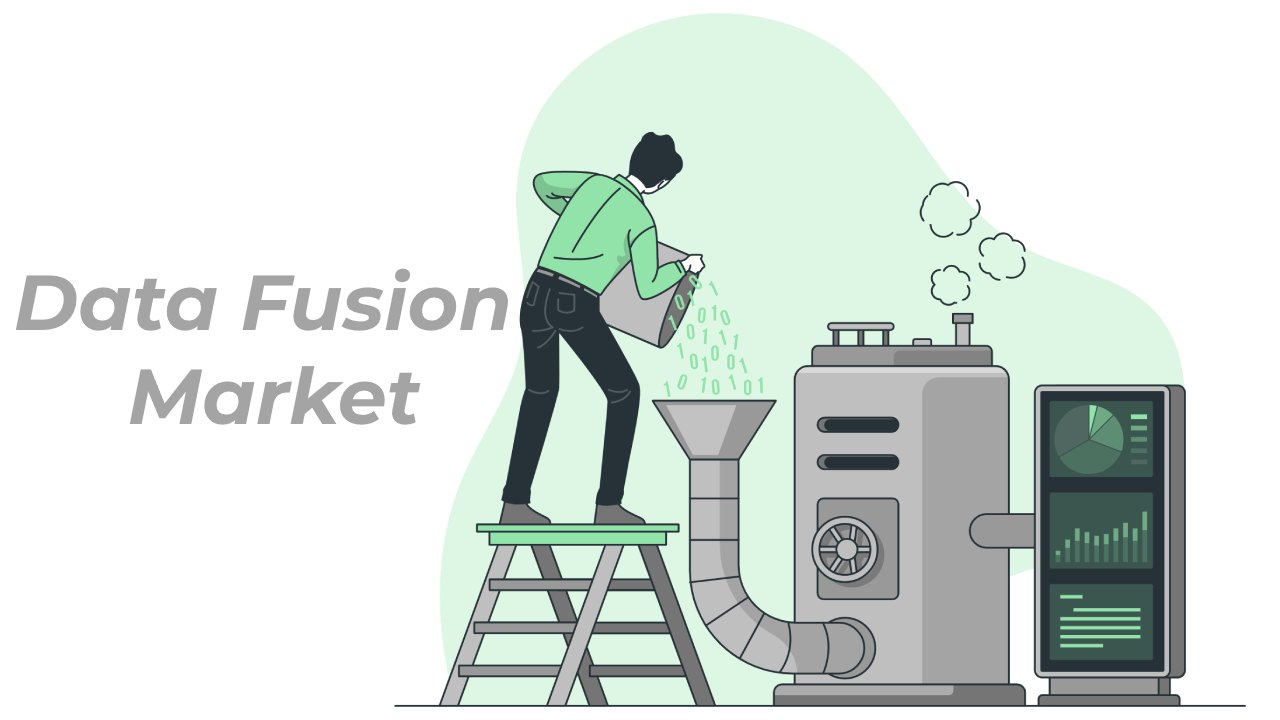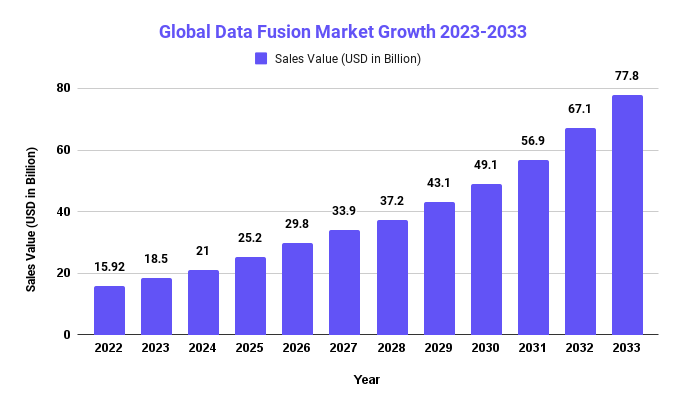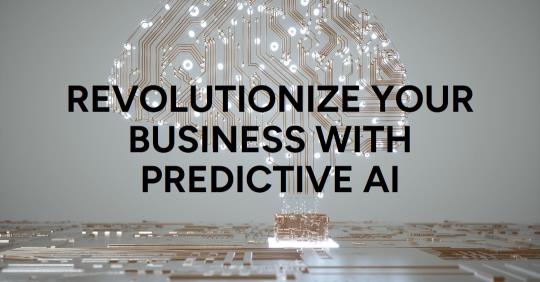Data Fusion Market Offers Key Insights To Boost Growth USD 77.8 Bn by 2033

Page Contents
Market Overview
Published Via 11Press: Data fusion Market is the process of combining data from multiple sources, such as sensors, databases, and other information systems, in order to generate more precise and exhaustive information. It involves integrating, correlating, and analyzing data from multiple sources to create a more complete and useful picture of a specific phenomenon, event, or circumstance.
The purpose of data fusion is to extract the most pertinent and accurate information from various data sources and to present this information in a manner that is meaningful and simple to comprehend. This process may employ techniques such as statistical analysis, machine learning algorithms, and expert systems, among others.
The Data Fusion Market size is expected to reach USD 77.8 Bn by 2033, up from its current value of USD 15.92 Bn in 2022, growing at an annual compound growth rate (CAGR) of 15.9% from 2023-2033.
Variety of Data Fusion Types
Sensor Fusion is the process of combining data from multiple sensors to generate a more accurate and comprehensive representation of a physical environment or situation. Combining data from cameras, lidar, and radar sensors, for instance, can enhance the accuracy of self-driving vehicles.
Information Fusion entails integrating data from various information systems, such as databases or data warehouses, to create a more comprehensive view of a specific domain or topic. For instance, combining regional sales data to obtain a better understanding of overall sales trends.
Combining the results of multiple decision-making models to make more informed choices. Combining the results of a weather forecasting model and a crop yield model, for instance, to make decisions regarding the planting and harvesting of crops.
There are numerous applications for data fusion in sectors such as defense, transportation, environmental monitoring, and healthcare. Using machine learning algorithms and other techniques, it enables organizations to automate decision-making processes and make better decisions based on more accurate and comprehensive information.
Key Takeaways
Data fusion is the process of integrating data from multiple sources to create a more accurate and comprehensive view of a specific phenomenon, event, or circumstance.
Various techniques, such as statistical analysis, machine learning algorithms, and expert systems, can be utilized in data fusion.
There are various forms of data fusion, such as sensor fusion, information fusion, and decision fusion.
There are numerous applications for data fusion in sectors such as defense, transportation, environmental monitoring, and healthcare.
Data fusion enables organizations to make better decisions based on more accurate and comprehensive data, as well as automate decision-making processes through the use of machine learning algorithms and other techniques.
The success of data fusion is contingent on the quality and relevance of the data, the precision of the algorithms and models employed, and the capacity to integrate and present the results effectively.
Data heterogeneity, uncertainty, and incompleteness, as well as assuring the data's security and privacy, are obstacles in data fusion.

Request Sample Copy of Data Fusion Market Report at: https://marketresearch.biz/report/data-fusion-market/request-sample/
Regional Snapshot
In North America, the United States Department of Defense has utilized data fusion for decades to incorporate data from various sensors and sources for military operations. For environmental monitoring, the National Aeronautics and Space Administration (NASA) also employs data fusion to combine data from multiple satellites and sensors.
The European Space Agency (ESA) is combining data from various Earth observation missions for climate change and environmental monitoring using data fusion. In addition, the European Union has established a Joint Research Centre devoted to data fusion for crisis management and security applications.
The Chinese government has launched a number of initiatives to promote data fusion in the Asia-Pacific region, including the Big Earth Data Science Engineering” project, which seeks to integrate data from multiple sources for environmental monitoring, disaster prevention, and resource management. Japan uses data fusion for disaster management as well, with the government investing in a system that incorporates data from multiple sensors and sources for real-time decision making.
The Dubai Police Force is utilizing data fusion to incorporate data from multiple sources, such as CCTV cameras, social media, and police reports, to improve public safety and security. Data fusion is used in South Africa to integrate data from multiple sources for wildlife conservation, such as monitoring the movements of elephants and rhinos.
In many regions of the globe, data fusion is used to improve decision-making, increase public safety and security, and monitor the environment. In the coming years, data fusion will likely become even more crucial as the volume and complexity of data continues to increase.”
Any inquiry, Speak to our expert at: https://marketresearch.biz/report/data-fusion-market/#inquiry
Drivers
As a result of the proliferation of digital devices and the expansion of the Internet of Things (IoT), the quantity of data being generated is exploding. Data fusion enables organizations to combine and analyze disparate data sources in order to obtain insights that would otherwise be impossible.
In many industries, including finance, healthcare, and transportation, there is a developing need for real-time insights to support decision-making. Data fusion enables organizations to analyze data from multiple sources in real-time in order to make fast, informed decisions.
Advances in Data Analytics: Improvements in data analytics, such as machine learning and artificial intelligence, have facilitated the analysis of large and complex data collections. Data fusion enables organizations to apply these analytic techniques to multiple data sources in order to derive deeper insights.
The increasing complexity of systems, such as smart communities and autonomous vehicles, necessitates the integration of data from multiple sources to ensure their effective and secure operation.
Data fusion can provide organizations with a competitive advantage by allowing them to obtain insights that their rivals lack. This can assist them in making better decisions, enhancing operational efficiency, and enhancing the customer experience.
The need to extract value from the vast amounts of data being generated and to obtain deeper insights that can inform decision-making and drive business outcomes is driving data fusion.
Restraints
For data fusion to be effective, high-quality data is required. Inaccurate, insufficient, or inconsistent data can result in incorrect conclusions and decisions.
Integrating data from multiple sources can be difficult, especially if the data is structured differently or stored in a variety of formats. This can necessitate significant resources and knowledge to ensure the correct integration of data.
Data fusion may entail sensitive data, such as personal information or trade secrets. Organizations must take precautions to ensure the privacy and security of their data.
Data fusion implementation can be difficult and resource-intensive. Organizations must ensure they have the necessary skills and resources to effectively manage and implement data fusion.
Data fusion can be costly, necessitating investments in hardware, software, and personnel to facilitate data integration and analysis.
The possibility of bias or discrimination is one ethical concern with data fusion. Organizations are required to use data fusion in an ethical and accountable manner.
Opportunities
Data fusion provides numerous opportunities for organizations to enhance their operations and realize their business goals. Here are some examples:
By integrating data from multiple sources, businesses can obtain a more comprehensive understanding of their operations, customers, and market. This can assist them in making better-informed judgments and reacting more quickly to changes.
Data fusion can assist organizations in identifying inefficiencies and development opportunities throughout their operations. By integrating data from multiple sources, organizations can gain insights into areas where costs can be reduced, processes can be streamlined, and performance can be enhanced.
Data fusion can help organizations obtain a deeper understanding of their customers and their preferences, thereby enhancing the customer experience. By integrating data from multiple sources, businesses can create a more relevant and personalized consumer experience.
New Revenue Streams: Data fusion can help organizations identify new revenue generation opportunities. By integrating data from multiple sources, organizations can obtain insights into previously unconsidered products, services, or markets.
Data fusion can assist organizations in identifying and mitigating risks throughout their operations. By integrating data from multiple sources, organizations can obtain a more comprehensive understanding of their risks, enabling them to take preventative measures to minimize potential losses.
Data fusion can contribute to innovation by allowing organizations to combine data from various sources and develop new products and services. This can help organizations maintain a competitive advantage and stimulate growth.
Challenges
While data fusion offers numerous benefits, implementing data fusion presents several obstacles that organizations must overcome.
For data fusion to be effective, high-quality data is required. Inaccurate, insufficient, or inconsistent data can result in incorrect conclusions and decisions.
Integrating data from multiple sources can be difficult, especially if the data is structured differently or stored in a variety of formats. This can necessitate significant resources and knowledge to ensure the correct integration of data.
Data fusion may entail sensitive data, such as personal information or trade secrets. Organizations must take precautions to ensure the privacy and security of their data.
Complexity: Data fusion implementation can be difficult and resource-intensive. Organizations must ensure they have the necessary skills and resources to effectively manage and implement data fusion.
Data fusion can be costly, necessitating investments in hardware, software, and personnel to facilitate data integration and analysis.
The possibility of bias or discrimination is one ethical concern with data fusion. Organizations are required to use data fusion in an ethical and accountable manner.
Legal and Regulatory Compliance: When accumulating, storing, and utilizing data, organizations must comply with legal and regulatory requirements. When integrating data from multiple sources that are subject to varying regulations, this can be challenging.
Data fusion necessitates collaboration and cooperation between various departments and functions within an organization. In organizations, overcoming cultural barriers and silos can be a significant challenge.
Market Segmentation
Industry
- Banking, Financial Services, and Insurance (BFSI)
- Telecom and IT
- Retail and consumer goods
- Healthcare and life sciences
- Manufacturing
- Government and defense
- Energy and utilities
- Transportation and logistics
- Media and entertainment
- Others
Deployment
- On-premises
- On-demand
Organization size
- Large enterprises
- Small
- Medium Enterprises (SMEs)
Components
- Tool
- Service
Services
- Managed services
- Professional services
- Consulting
- Deployment and integration
- Support and maintenance
Key Players
- InvenSense
- Esri
- INRIX
- AGT International
- Palantir Technologies
- Clarivate Analytics
- LexisNexis
- Thomson Reuters Cogint
- Merrick & Company
Report Scope
| Report Attribute | Details |
| Market size value in 2022 | USD 15.92 Bn |
| Revenue forecast by 2033 | USD 77.8 Bn |
| Growth Rate | CAGR Of 15.9% |
| Regions Covered | North America, Europe, Asia Pacific, Latin America, and Middle East & Africa, and Rest of the World |
| Historical Years | 2017-2022 |
| Base Year | 2022 |
| Estimated Year | 2023 |
| Short-Term Projection Year | 2028 |
| Long-Term Projected Year | 2033 |
Request Customization Of The Report: https://marketresearch.biz/report/data-fusion-market/#request-for-customization
Recent Developments
Data fusion has become more potent and efficient as a result of the accelerated development of machine learning techniques. Recent advancements in deep learning, reinforcement learning, and natural language processing have enabled organizations to analyze vast quantities of data from various sources and obtain valuable insights.
With the proliferation of IoT devices, organizations seeking to extract value from IoT data must now prioritize data fusion. By integrating data from various IoT devices, businesses can obtain a more comprehensive understanding of their operations and make more informed decisions.
Adoption of Cloud Computing: The adoption of cloud computing has facilitated the implementation of data fusion by providing organizations with access to scalable computing resources and data storage. In addition, cloud computing facilitates the sharing of data across departments and functions within an organization.
As data becomes increasingly valuable, organizations place a greater emphasis on data privacy and security. With the introduction of regulations such as GDPR and CCPA, organizations implementing data fusion must take the necessary precautions to safeguard the privacy and security of their data.
Data marketplaces are platforms that allow organizations to purchase and sell data from various sources. Data marketplaces are gaining popularity as organizations seek to access a broader variety of data sources and integrate them through data fusion techniques.
Data fusion is increasingly being used in healthcare to integrate data from disparate sources, such as electronic health records, medical imaging, and wearables. By integrating these data, healthcare organizations can obtain a more comprehensive understanding of patient health, allowing for more effective, personalized care.
These recent advancements in data fusion are driving increased adoption and innovation, and will likely continue to influence the field's future.
Key Questions
What exactly is data fusion?
Data fusion is the process of combining data from multiple sources to form a more comprehensive and accurate picture of a system or phenomenon.
Why is data fusion so essential?
Data fusion is essential because it enables organizations to make more informed decisions by providing a more complete picture of their operations, customers, and market. By integrating data from multiple sources, organizations are able to identify trends, opportunities, and hazards of which they may have been unaware.
What are some examples of applications utilizing data fusion?
There are numerous applications for data fusion, including in the disciplines of finance, healthcare, transportation, and defense. In finance, for instance, data fusion can be used to combine data from various financial instruments to produce a more accurate depiction of market trends. In healthcare, data fusion can be used to combine information from electronic health records, medical imaging, and wearables to generate a more complete picture of patient health.
What are the obstacles associated with implementing data fusion?
Due to issues such as data quality, data integration, data privacy and security, complexity, cost, ethics, legal and regulatory conformance, and cultural barriers, implementing data fusion can be difficult.
What advantages does data fusion offer?
The benefits of data fusion include enhanced decision-making, increased efficiency, enhanced consumer experience, new revenue streams, enhanced risk management, and innovation.
What are some recent data fusion advancements?
Recent advancements in data fusion include advances in machine learning, integration with the Internet of Things, adoption of cloud computing, a greater emphasis on data privacy and security, the emergence of data marketplaces, and applications in healthcare.
Contact us
Contact Person: Mr. Lawrence John
Marketresearch.Biz (Powered By Prudour Pvt. Ltd.)
Tel: +1 (347) 796-4335
Send Email: [email protected]
Content has been published via 11press. for more details please contact at [email protected]
The team behind market.us, marketresearch.biz, market.biz and more. Our purpose is to keep our customers ahead of the game with regard to the markets. They may fluctuate up or down, but we will help you to stay ahead of the curve in these market fluctuations. Our consistent growth and ability to deliver in-depth analyses and market insight has engaged genuine market players. They have faith in us to offer the data and information they require to make balanced and decisive marketing decisions.



